Vacuum pressure transducers with voltage outputs (0-5V, 0-10V, 0.5-4.5V). Select absolute or gauge references for partial/full vacuum ranges.
Voltage output vacuum pressure transducers are essential components for quantifying pressure levels below atmosphere, providing a linear electrical signal (such as 0-5V, 0-10V, or 0.5-4.5V) directly proportional to the measured vacuum. Whether monitoring partial vacuums in industrial automation or controlling high vacuum environments in research, these devices offer critical process insights. Key considerations when selecting a transducer include choosing between an absolute reference for measurements independent of barometric pressure or a gauge reference for readings relative to ambient conditions, ensuring appropriate material compatibility with process gases to prevent corrosion or outgassing, and selecting suitable process connections to guarantee seal integrity across the required vacuum range.
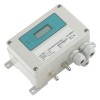 DPS Low Differential Pressure Transmitter - Ultra low differential pressure transmitter for HVAC applications with 4-20mA current loop or amplified voltage output signal in pressure ranges from 0.1 mb up to 1 bar differential.
DPS Low Differential Pressure Transmitter - Ultra low differential pressure transmitter for HVAC applications with 4-20mA current loop or amplified voltage output signal in pressure ranges from 0.1 mb up to 1 bar differential. 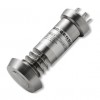 DMP331P Hygienic Flush Pressure Transmitter - Sanitary pressure sensor wth exposed diaphragm with no crevices for high temperatures up to 300 Degrees Celsius in ranges from 100mb up to 40 bar gauge or absolute
DMP331P Hygienic Flush Pressure Transmitter - Sanitary pressure sensor wth exposed diaphragm with no crevices for high temperatures up to 300 Degrees Celsius in ranges from 100mb up to 40 bar gauge or absolute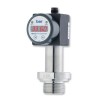 DS200P Sanitary Low Range Pressure Gauge, Switch and Sensor - All in one electronic switch, gauge and sensor designed specifically for use in the food, drink and biomedical industry for measuring process pressures.
DS200P Sanitary Low Range Pressure Gauge, Switch and Sensor - All in one electronic switch, gauge and sensor designed specifically for use in the food, drink and biomedical industry for measuring process pressures.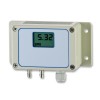 DPS200 HVAC Differential Pressure Transmitter - Differential air pressure sensor with a 10 volt or a 4-20mA output for building ventilation applications. Ranges from 0 to 6 mbar up to 0 to 1000 mbar.
DPS200 HVAC Differential Pressure Transmitter - Differential air pressure sensor with a 10 volt or a 4-20mA output for building ventilation applications. Ranges from 0 to 6 mbar up to 0 to 1000 mbar.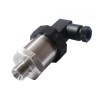 IMP Low Cost Pressure Sensor - Versatile low price pressure sensor with a wide selection of electrical and mechanical options for customisation.
IMP Low Cost Pressure Sensor - Versatile low price pressure sensor with a wide selection of electrical and mechanical options for customisation. DPS300 User Switchable Pressure Range, Volts or Current Output Low DP Sensor - The DPS 300 is a low range HVAC differential pressure sensor. The lowest possible pressure range is 0...100 pascals. 2 or 3 switchable pressure ranges, plus volts or current output are included with most standard configurations.
DPS300 User Switchable Pressure Range, Volts or Current Output Low DP Sensor - The DPS 300 is a low range HVAC differential pressure sensor. The lowest possible pressure range is 0...100 pascals. 2 or 3 switchable pressure ranges, plus volts or current output are included with most standard configurations.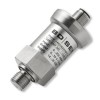 DMP343 Low Range Pneumatic Pressure Sensor - DMP343 pneumatic pressure sensor for measuring very low range pressures on pneumatic control systems, heating, ventilation and air conditioning systems (HVAC) .
DMP343 Low Range Pneumatic Pressure Sensor - DMP343 pneumatic pressure sensor for measuring very low range pressures on pneumatic control systems, heating, ventilation and air conditioning systems (HVAC) .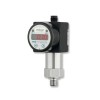 DS210 Combined Low Pressure Switch, Indicator and Sensor - Low range three in one pressure switch, pressure indicator and pressure sensor for use on pneumatics and HVAC applications.
DS210 Combined Low Pressure Switch, Indicator and Sensor - Low range three in one pressure switch, pressure indicator and pressure sensor for use on pneumatics and HVAC applications.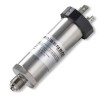 DMP331i High Accuracy Pressure Transmitter - High precision pressure transmitter with an accuracy of 0.1%FS BSL NLHR and digitally adjustable pressure ranges from 400mb up to 40 bar gauge & absolute.
DMP331i High Accuracy Pressure Transmitter - High precision pressure transmitter with an accuracy of 0.1%FS BSL NLHR and digitally adjustable pressure ranges from 400mb up to 40 bar gauge & absolute.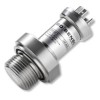 DMK331P Flush Diaphragm Pressure Sensor - Screw-in pressure transmitter with flush stainless steel 316L diaphragm for measuring pressures of fluids with very high viscosity from 900 up to 6000 psi
DMK331P Flush Diaphragm Pressure Sensor - Screw-in pressure transmitter with flush stainless steel 316L diaphragm for measuring pressures of fluids with very high viscosity from 900 up to 6000 psi IMPLR Low Range All Stainless Steel OEM Pressure Sensor - Low cost sensor for measuring small pressure ranges from 0-50 mbar (10 inH2O) to 0-1000 mbar (15 psi) of liquids or gases.
IMPLR Low Range All Stainless Steel OEM Pressure Sensor - Low cost sensor for measuring small pressure ranges from 0-50 mbar (10 inH2O) to 0-1000 mbar (15 psi) of liquids or gases.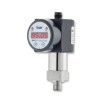 DS200 Combined Pressure Switch, Gauge and Sensor - Three in one electronic pressure switch, digital pressure gauge and pressure sensor with pressure ranges from 100 mbar up to 600 bar (1.5 to 9000 psi).
DS200 Combined Pressure Switch, Gauge and Sensor - Three in one electronic pressure switch, digital pressure gauge and pressure sensor with pressure ranges from 100 mbar up to 600 bar (1.5 to 9000 psi).
- Vacuum and steamer pressure transducer with -30 inHg to 100 psi range
- -0.9 to +2.2 bar g Autoclave pressure transducer
- 300 mmHg absolute vacuum pressure transducer with 10 volts output
Find out more about Vacuum Pressure Transducers to determine which product options and capabilities will best meet your application requirements.
Vacuum pressure transducers provide a precise analogue voltage output, typically scaled linearly across a specific vacuum range. These devices are fundamental in applications requiring quantified measurements below atmospheric pressure, translating the physical vacuum level into a readily usable electrical signal, often 0-5Vdc, 0-10Vdc, 1-5Vdc or the ratiometric 0.5-4.5Vdc favoured in OEM and battery-powered systems. The choice of output signal depends heavily on the interfacing instrumentation, with 0-10V often preferred for industrial PLC systems and 0.5-4.5V for lower power consumption requirements.
Selecting the correct pressure reference is critical when specifying a vacuum transducer. An absolute reference transducer measures pressure relative to a perfect vacuum (zero pressure), ideal for applications where the measurement must be independent of barometric pressure fluctuations, such as in vacuum drying processes, altitude simulation chambers, or scientific research requiring precise low-pressure readings like 0 to 500 mbar absolute. Conversely, a gauge reference transducer measures vacuum relative to the ambient atmospheric pressure. These are often specified with negative ranges (e.g., 0 to -1 bar gauge, or 0 to -15 psig) and are commonly used in applications like vacuum holding systems, leak detection comparing internal vacuum to ambient conditions, or monitoring vacuum pump performance relative to atmosphere.
Defining the measurement range accurately ensures optimal performance. Transducers can be scaled for partial vacuum ranges, such as monitoring the headspace vacuum in food packaging or controlling moderate vacuum levels in moulding processes. Alternatively, transducers scaled for the full vacuum range (e.g., atmospheric pressure down to near absolute zero) are necessary for applications like vacuum furnace control, thin-film deposition systems, or general-purpose laboratory vacuum systems. Specifying a range that closely matches the application’s working vacuum level generally yields better resolution and accuracy where it’s most needed.
Accuracy requirements for vacuum transducers must consider the entire measurement span. Stating accuracy as a percentage of full scale (%FS) is common, but it’s crucial to understand its implication, especially at the lower end of the vacuum range (approaching full vacuum). Non-linearity and thermal errors can become more significant at very low absolute pressures. Therefore, considering accuracy specifications in specific vacuum units (mbar, Torr, Pa, inHg, psi) relevant to the critical part of the process range can be more informative for applications like vacuum distillation or freeze-drying where precise control at low pressure is vital.
The choice of electrical connection interfaces directly with the control system or data acquisition hardware. Options typically include flying leads, integral cables of specified lengths, or standardized connectors such as M12, DIN 43650, or Binder types. Ensuring compatibility simplifies installation and maintenance, particularly in industrial settings or complex experimental setups. Shielded cables may be necessary in environments with high electrical noise to preserve signal integrity from the transducer to the instrumentation.
Material compatibility is paramount in vacuum applications due to the diverse gases and vapours encountered, extending beyond just air evacuation. The wetted materials of the transducer, typically including the sensing diaphragm and the process connection thread, must resist corrosion or reaction with the process media. Common materials like 316 stainless steel are suitable for many applications, but specialized alloys or elastomers might be required for aggressive gases found in semiconductor manufacturing or chemical processing. Furthermore, in high vacuum systems, material outgassing must be minimized, favouring stainless steel and specific elastomers or metal seals to avoid contaminating the vacuum environment and ensure accurate low-pressure measurement.
Process connections for vacuum transducers must provide a reliable, leak-tight seal appropriate for the target vacuum level. While standard threaded connections like NPT or BSP are common for lower vacuum levels, higher vacuum applications (typically below 1 mbar absolute) often necessitate specialized vacuum fittings. Options such as KF (QF), ISO-K, CF (Conflat), or VCR/VCO fittings provide superior sealing integrity using elastomer or metal seals, crucial for maintaining vacuum purity and achieving low ultimate pressures in research chambers, surface analysis systems, or particle accelerators. The selection directly impacts the system’s ability to reach and hold the desired vacuum level.
Product Help
Specifying vacuum pressure transducer requirements
Some questions to ask when defining the product requirements for a vacuum pressure transducer.
Vacuum range
What range of vacuum do you need to measure, is it over the whole range from atmospheric pressure to a high vacuum, or a partial vacuum such as reducing the pressure to 90% atmospheric pressure?
Reference type
Are you measuring vacuum relative to full vacuum reading, which would need an absolute reference, or are you measuring vacuum relative to atmospheric pressure, which would require a gauge reference?
Voltage output type
What voltage output scaling is required for the vacuum transducer signal, e.g. 0-5V, 0-10V, 1-5V, or 0.5-4.5V?
Accuracy
How accurate does the vacuum reading need to be in % of full range or vacuum units such as mbar, Torr, inHg, mmHg or psi?
Electrical connection
Do you have a preferred way of connecting the voltage output signal to your vacuum measurement instrumentation?
Do you need a connector or a cable supplied with the transducer?
Media type
What is the vacuum medium being measured? A vacuum measurement application often involves the removal of air, but it can involve any type of gas, and this may affect the suitability of materials used in the construction of the transducer, so it is an important consideration to ensure the long term reliability of the vacuum pressure transducer.
Process connection
Do you have a preferred vacuum connection for mounting the transducer? The level of vacuum being applied can influence the type of connection required, particularly high vacuums where vacuum compatible materials and vacuum seal integrity becomes more restrictive.
Checklist for vacuum pressure transducer requirements
Define your vacuum pressure transducer requirements using this checklist:
- Vacuum range?
- Reference type?
- Voltage output type?
- Accuracy?
- Electrical connection?
- Media type?
- Process connection?
